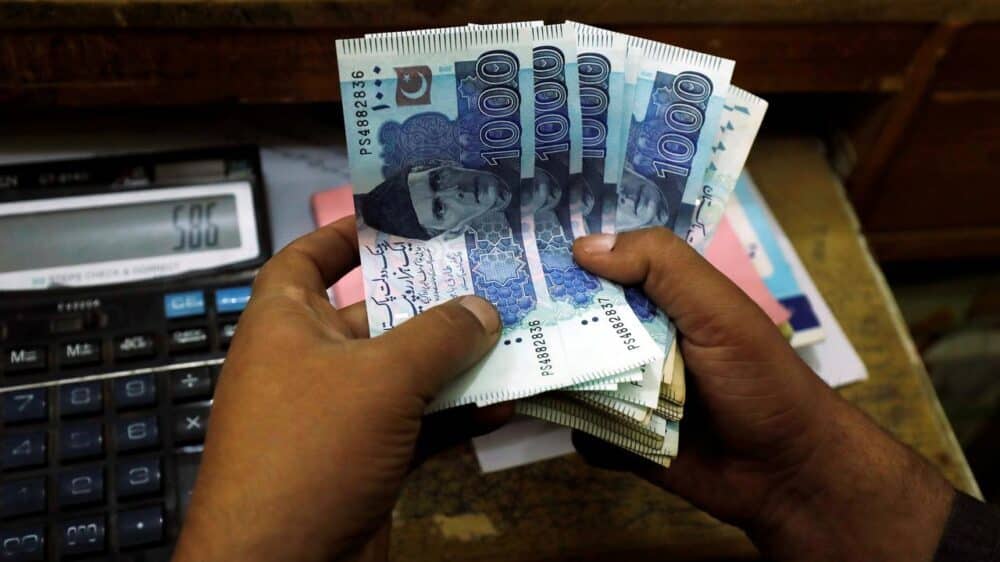Pakistan’s total public debt was recorded at Rs. 38.006 trillion at end of March 2021 compared to Rs. 36.399 trillion at the end of June 2020, registering an increase of Rs. 1.607 trillion during the first nine months of the current fiscal year, revealed Economic Survey (2020-21).
The survey noted that the increase of Rs. 1.607 trillion during the first nine months of the current fiscal year was much less when compared with the increase of Rs. 2.499 trillion witnessed during the same period last year.
“Pakistan has been able to contain the growth in its public debt portfolio despite a very challenging macroeconomic situation around the globe due to the pandemic. In fact, Pakistan witnessed one of the smallest increases in its public debt,” added the survey report.
The increase in total public debt during the first nine months of the current fiscal year was lower than Federal Government borrowing of Rs. 2.065 trillion for the financing of its fiscal deficit.
The differential is primarily attributable to the appreciation of Pak Rupee against US Dollar by around 9 percent, which led to a decrease in the value of external public debt when converted into Pak Rupees, it added.
Pakistan has witnessed one of the smallest increases in its public debt during the pandemic. The global public Debt-to-GDP ratio increased by 13 percentage points, from 84 percent in 2019 to 97 percent in 2020, whereas, Pakistan’s Debt-to-GDP Ratio witnessed a minimal increase of 1.7 percentage points and stood at 87.6 percent at the end of June 2020 compared with 85.9 percent at the end of June 2019.
The Debt-to-GDP ratio of Pakistan is expected to reduce and will remain below 84 percent at the end of the current fiscal year, it added.
The survey noted that external public debt was recorded at $81.6 billion at the end of March 2021, increasing by around $3.6 billion during the first nine months of the current fiscal year. The increase reveals that debt from multilateral and bilateral sources increased by $2.2 billion. This amount also includes $0.5 billion received from the IMF under Extended Fund Facility (EFF).
The stock of Pakistan Banao Certificates and Naya Pakistan Certificates cumulatively registered an increase of $0.4 billion.
Gross external loan disbursements were recorded at $7.724 billion during the first nine months of 2020-21, including disbursements from multilateral sources amounted to $3.397 billion and accounted for 44 percent of the total disbursements.
Bilateral sources contributed $1.207 billion or 16 percent in total disbursements. Out of this, SAFE Deposits from China amounted to $1,000 million; and commercial loans contributed $3.12 billion or 40 percent in total disbursements.
ALSO READ
Manufacturing, Agriculture and Construction Industries Aided Economic Recovery
External public debt repayments were recorded at $5.147 billion during the first nine months of the current fiscal year compared with $5.537 billion during the same period last year. This reduction in repayments is primarily due to the DSSI initiative and no repayment of Eurobonds/Sukuks during the current fiscal year.
Interest payments were recorded at $1.08 billion during the first nine months of the current fiscal year compared to $1.58 billion during the same period of the preceding year.
Interest servicing was recorded at Rs. 2,104 billion during the first nine months of the current fiscal year against its annual budgeted estimate of Rs. 2,946 billion. Domestic interest payments were recorded at Rs. 1,934 billion and constituted around 92 percent of total interest servicing during the first nine months of the current fiscal which is mainly attributable to a higher volume of domestic debt in the total public debt portfolio.
On a full-year basis (2020-21), interest servicing is expected to remain below the budgeted estimates primarily due to extension of DSSI from January to June 2021, appreciation of Pak Rupee against US Dollar and lower interest servicing on account of National Savings Schemes due to withdrawals against discontinued prize bonds.
In addition to net external inflows, the following factors influenced the movement in external public debt stock during the first nine months of the current fiscal year: in US Dollar terms, revaluation loss owing to the depreciation of the US Dollar against other international currencies increased the external public debt stock by around $1.1 billion.
This increase was mainly driven by the depreciation of the US Dollar against the Chinese Yuan by 8 percent, Euro by 5 percent, and Special Drawing Right (SDR) by 3 percent. The above-mentioned translational loss on account of depreciation of the US Dollar against other international currencies was more than offset by the appreciation of Pak Rupee against the US Dollar by 9 percent, which led to reduce the Rupee value of the external public debt.
Domestic debt was recorded at Rs. 25.552 trillion at end-March 2021, registering an increase of Rs. 2.27 trillion during the first nine months of the current fiscal year.
ALSO READ
Finance Minister Unveils Economic Survey FY2020-21
The survey noted that permanent debt constituted 62 percent of the domestic debt portfolio and was recorded at Rs. 15.882 trillion at end-March 2021, representing an increase of Rs. 1.852 trillion during the first nine months of the ongoing fiscal year.
The bifurcation of this increase reveals that government net mobilization through the issuance of PIBs and GIS was Rs. 1,488 billion and Rs. 439 billion respectively, whereas a net retirement amounting to Rs. 74 billion was observed in Prize Bonds due to the discontinuation of prize bonds of various denominations.
Floating debt was recorded at Rs. 6,000 billion or around 24 percent of the total domestic debt portfolio at the end of March 2021. During the first nine months of the ongoing fiscal year, net mobilization through the issuance of T-bills was Rs. 421 billion.
The stock of unfunded debt stood at Rs. 3,652 billion at the end of March 2021, constituted around 14 percent of the total domestic debt portfolio. Unfunded debt recorded a net reduction of Rs. 22 billion during the first nine months of the current fiscal year.
The survey noted that misaligned economic policies of the past, including large fiscal deficits, loose monetary policy, and defense of an overvalued exchange rate, fuelled consumption and short-term growth but steadily eroded macroeconomic buffers, increased external debt, inflated current account deficit, and depleted international reserves.
External public debt to foreign exchange reserves ratio improved and recorded at 4.1 times during 2019-20 compared with 5.1 times during last fiscal year, on the back of a slowdown in fresh accumulation of debt and the rise in the country’s foreign exchange reserves.
Growth in external public debt servicing, mainly driven by repayments of Eurobonds and commercial loans, which outpaced the growth in FEE and accordingly external public debt servicing to foreign exchange earnings ratio increased to 20.4 percent in 2019-20 compared with 17.2 percent in 2018-19.
With the improved balance of payment situation, external debt sustainability is expected to improve further going forward.
Pakistan entered the international capital market in April 2021 after a gap of over three years by successfully raising $ 2.5 billion through a multi-tranche transaction of 5-, 10- and 30-year Eurobonds.
Pakistan’s strategy to reduce its debt burden to a sustainable level includes a commitment to run primary surpluses, maintain low and stable inflation, promote measures that support higher long-term economic growth and follow an exchange rate regime based on economic fundamentals. With a narrower fiscal deficit, public debt is projected to enter a firm downward path while the government’s efforts to improve maturity structure will enhance public debt sustainability.

























